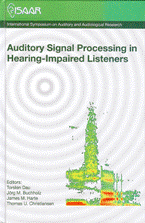Listening in a multisource environment with and without hearing aids
Resumé
The aim of the current study was to examine the challenge faced by listeners with hearing loss when selectively attending to one source in the presence of multiple competing sources and reverberation. In a series of experiments, both younger and older listeners with normal hearing or bilateral symmetric sensorineural hearing loss served as subjects. The listeners with hearing loss were experienced users of bilateral hearing aids and were tested unaided, bilaterally aided, and unilaterally aided. The task was to repeat key words spoken by a target talker located straight ahead in the presence of two colocated or symmetrically spatially separated competing talkers. On average, listeners with normal hearing demonstrated a large benefit of spatial separation which was somewhat reduced when the room reverberation was increased. The presence of bilateral sensorineural hearing loss decreased this benefit in both room conditions. Listening through bilateral personal amplification was not significantly different from unaided listening (at an adequate sensation level). However, when listening with one ear aided and one ear unaided the already small benefit was somewhat reduced. Current results suggest an interaction between peripheral hearing loss, hearing aid use, reverberation and performance in an auditory spatial attention task and present a challenge to current models.
Referencer
Bronkhorst, A. (2000). "The cocktail party phenomenon: A review of research on speech intelligibility in multiple-talker conditions," Acust. Acta Acust., 86, 117–128.
Ebata, M. (2003). “Spatial unmasking and attention related to the cocktail party problem,” Acoust. Sci. Tech. 24, 208-219.
Gatehouse, S., and Noble, W. (2004). “The Speech, Spatial, and Qualities of Hearing Scale (SSQ),” Int. J. Audiol. 43, 85-99.
Harkins, J., and Tucker, P. (2007). “An internet survey of individuals with hearing loss regarding assistive listening devices,” Trends Ampl., 11, 91-100.
Kidd, J. G., Mason, C. R., Brughera, A., and Hartmann, W. M. (2005). “The role of reverberation in release from masking due to spatial separation of sources for speech identification,” Acust. Acta Acust., 91, 526-536.
Kidd, G. Jr., Mason, C. R., Richards, V. M., Gallun, F. J., and Durlach, N. (2007). "Informational masking," in Auditory Perception of Sound Sources, edited by W.A. Yost (Springer, New York).
Marrone, N. L., Mason, C. R., and Kidd, G. Jr. (2007a). “Tuning in the spatial dimension: Evidence from a masked speech identification task,” (under review).
Marrone, N. L., Mason, C. R., and Kidd, G. Jr. (2007b). “Effect of hearing loss on the bene t of spatial separation between multiple talkers in reverberant rooms,” (under review).
Van den Bogaert, T., Klasen, T. J., Moonen, M., Van Deun, L., and Wouters, J. (2006). “Horizontal localization with bilateral hearing aids: without is better than with,” J. Acoust. Soc. Am. 119, 515-526.
Yost, W. A. (1997). “The cocktail party problem: Forty years later,” in Binaural and Spatial Hearing in Real and Virtual Environments, edited by R. A. Gilkey and T. R. Anderson. Mahwah, NJ, Lawrence Erlbaum, 329-348.
Yderligere filer
Publiceret
Citation/Eksport
Nummer
Sektion
Licens
Authors who publish with this journal agree to the following terms:
a. Authors retain copyright* and grant the journal right of first publication with the work simultaneously licensed under a Creative Commons Attribution License that allows others to share the work with an acknowledgement of the work's authorship and initial publication in this journal.
b. Authors are able to enter into separate, additional contractual arrangements for the non-exclusive distribution of the journal's published version of the work (e.g., post it to an institutional repository or publish it in a book), with an acknowledgement of its initial publication in this journal.
c. Authors are permitted and encouraged to post their work online (e.g., in institutional repositories or on their website) prior to and during the submission process, as it can lead to productive exchanges, as well as earlier and greater citation of published work (See The Effect of Open Access).
*From the 2017 issue onward. The Danavox Jubilee Foundation owns the copyright of all articles published in the 1969-2015 issues. However, authors are still allowed to share the work with an acknowledgement of the work's authorship and initial publication in this journal.


